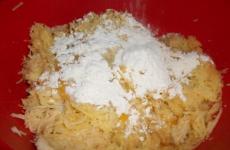Instant salted Chinese cabbage. Korean-style Beijing cabbage
Many people are attracted not by ordinary cabbage, but by Chinese cabbage. And not only due to its soft taste, but also due to the combination of the crispy middle of the leaf and its tender edges. Therefore, it is Chinese cabbage that is canned or salted for the winter by many housewives.
Many people are attracted not by ordinary cabbage, but by Beijing cabbage
Most often, salads or main courses are prepared from Chinese cabbage. Interestingly, Chinese cabbage goes well with seafood, sausages, and other vegetables and fruits. When preparing salads and dishes from this product, you should take into account that it cannot be combined with cream, milk and yogurt, otherwise such an interaction may cause gastrointestinal upset.
When preparing main courses, Chinese cabbage should not be subjected to long-term processing. The best way To prepare the vegetable, blanch it for 10-20 seconds. This product will be an excellent ingredient for preparing cabbage rolls, stews, various rolls, and casseroles. Such dishes should be served with sour cream or mushroom sauce.
Recipes from Chinese cabbage for the winter (video)
Recipe: chamcha for the winter
Chamcha is a rather spicy dish that helps to cope with various pathogens and also improve immunity.
To prepare it you will need:
- 1.2 kilos of Chinese cabbage;
- 250 grams of daikon;
- 120 grams of carrots;
- 30 grams of ginger;
- 1 garlic head;
- 50 grams of leek;
- 50 grams of onions;
- 30 milliliters of soy sauce;
- 1 chili pod;
- 30 grams of rice flour;
- 40 grams of sugar;
- 50 grams of salt.
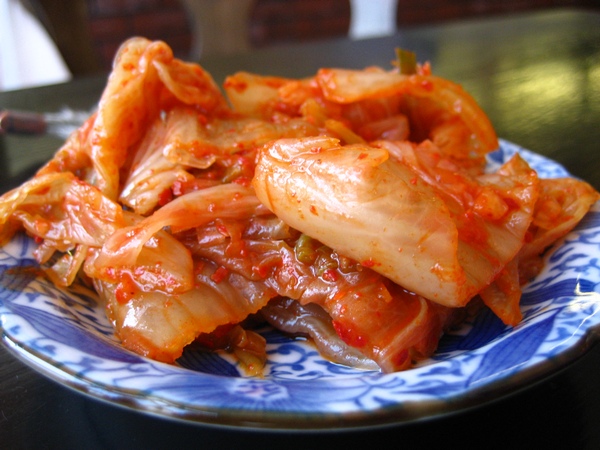 Chamcha is a rather spicy dish
Chamcha is a rather spicy dish How to cook:
- The head of cabbage is washed and cut into 4 parts. The stalk is removed from each part.
- The leaves are salted, the cabbage is placed in a pan under a load. Everything is left in this state for 7 hours.
- At this time, the filling is being prepared. Pour rice flour and sugar into 400 milliliters of water, mix everything until smooth, put on low heat and cook until thick.
- Next, the spicy paste is made. Finely chopped garlic, ginger, chili, and onion are mixed in a container. Everything gets mixed up.
- Carrots and daikon are washed, peeled, and grated into strips.
- All cooked vegetables are mixed with filling and soy sauce.
- The salted cabbage is washed, excess salt is removed, and the moisture is removed with a paper towel.
- Each leaf is coated with hot paste.
- All the leaves are placed in a pan with pouring.
- The pan is closed with a lid, the mass is brought to a temperature of 95 degrees.
- The hot chamcha snack is placed in sterilized jars, rolled up, turned over and wrapped in a warm towel.
When placing snacks in jars, you must ensure that the leaves are placed evenly in the container, otherwise the snack will lose its attractive appearance.
Kimchi salad: a simple recipe
For spicy lovers, there are various recipes for making Chinese cabbage kimchi. The following recipe is considered one of the best.
Ingredients:
- a kilo of Chinese cabbage;
- chili pod;
- garlic head;
- 4 tablespoons of salt;
- 2 tablespoons of vinegar;
- 100 milliliters of soy sauce;
- 4 ginger;
- 3 onions;
- 2 tablespoons of sugar;
- 2 tablespoons ground paprika.
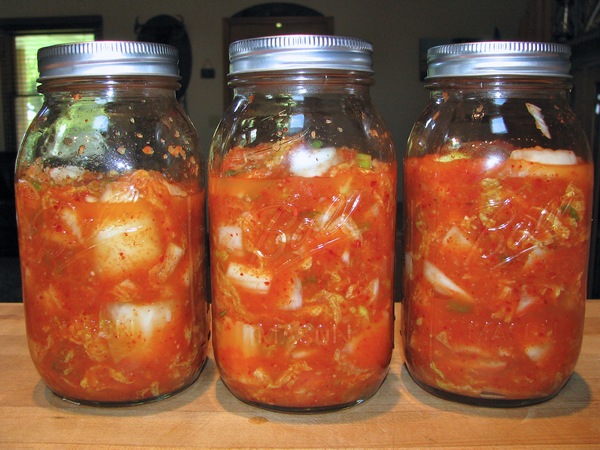 For spicy lovers, there are various recipes for making Chinese cabbage kimchi.
For spicy lovers, there are various recipes for making Chinese cabbage kimchi. Step by step method preparations:
- Chinese cabbage is washed and peeled upper leaves, is freed from the stalk.
- The resulting head of cabbage is cut into 4 parts. Next, the cabbage is cut into pieces with sides of 2-3 centimeters.
- All cabbage pieces are placed in a deep container and sprinkled with salt. The dishes are closed and sent to a cool place for 24 hours.
- After the end of the day, the released cabbage juice is drained.
- The onion is peeled and cut into half rings.
- The garlic is peeled and passed through a press.
- Chili is freed from the stalk and cut into thin slices.
- Ginger is grated on a fine grater.
- All prepared ingredients are mixed and poured into the cabbage leaves.
- In a separate container, mix soy sauce with sugar, paprika, vinegar and a small amount of water. The resulting filling is poured into the cabbage.
- Everything is mixed, covered with a lid and infused for 2-3 days in the refrigerator.
This recipe is not suitable for cooking long-term storage, so after insisting cabbage leaves kimchi should be consumed within a week.
How to salt Chinese cabbage for the winter?
Peking cabbage can also be pickled in jars for the winter.
To do this you need:
- 1 kilo of Chinese cabbage;
- 100 grams of salt.
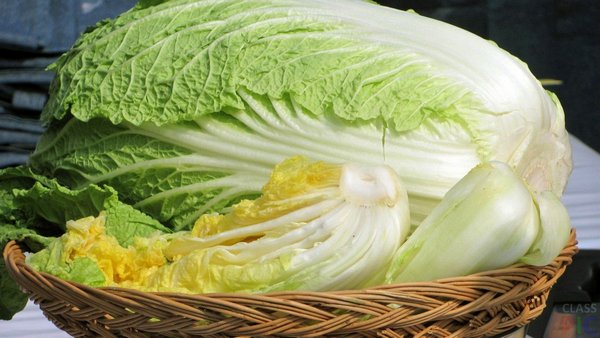 Peking cabbage can also be pickled for the winter.
Peking cabbage can also be pickled for the winter. Salting is carried out using the following technology:
- The head of cabbage is washed and chopped into strips in the same way as for pickling white cabbage. If the cabbage will be stored in large containers, you can not chop it into strips, but cut it into rectangles.
- Cabbage straws are poured into a deep container. Then it should be salted. Everything is mixed and lightly pressed so that the leaves are not too wrinkled. Otherwise, the salted cabbage will lose its crunchy texture.
- A pressure is placed on top of the straw. The mass should be fermented for 1 month.
- During salting, you are allowed to remove the pressure and taste the product to see if there is enough salt. At the moment when the snack is salty enough, it can be placed in sterilized jars and placed in the refrigerator.
After all the pickled pulp has been distributed into jars, the remaining brine should be distributed over them.
Pickled Chinese cabbage: cooking method
For pickling, it is better to use only the hard parts of the cabbage leaf; they will be able to retain their juiciness and crispy structure in the prepared product. To make pickled Peking at home, you need:
- a kilo of Chinese cabbage;
- 5 tablespoons of sugar;
- 1 dining spoon of salt;
- 1 chili pod;
- 90 milliliters of 9% table vinegar.
How to do it:
- Pekinka (without stalk) is divided into leaves. Each leaf has a hard piece cut out white part, which is chopped into strips and transferred to a separate deep container.
- The chili is washed, freed from seeds and stalks, cut into small cubes.
- The pepper is transferred into cabbage strips. Salt is added to the mass, everything is mixed and infused in the refrigerator for an hour.
- At this time, the marinade is being prepared. To do this, add sugar to the vinegar, mix everything and bring to a boil.
- Boiling marinade is poured into the vegetable mixture and everything is mixed.
- After a couple of minutes, the salad is laid out in clean jars and filled with marinade.
- The containers are covered with lids and placed in boiling water for 15 minutes to sterilize.
- Then the container is removed from the water, rolled up, turned over, wrapped in a warm towel and left to cool.
It is worth considering that pickled cabbage should be compacted into jars. Only in this case there will be enough marinade for all the raw materials.
Beijing cabbage: step-by-step recipe for cooking in Korean
Korean-style Beijing, or as it is also called - kimchi, turns out to be spicy and crispy, so it can be offered to the table as an appetizer and addition to main courses. Spicy cabbage can be fermented using the following ingredients:
- 1 whole head of pekinka;
- 1 bell pepper;
- 1 chili pod;
- garlic head;
- a little ground pepper and cilantro seeds.
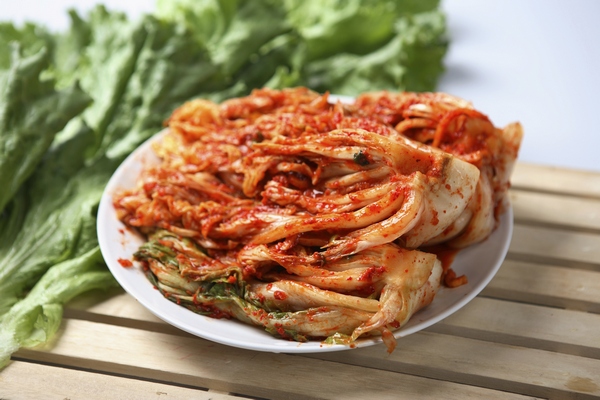 Korean-style Beijing, or as it is also called - kimchi, turns out to be spicy and crispy
Korean-style Beijing, or as it is also called - kimchi, turns out to be spicy and crispy How to salt and marinate:
- First of all, the head of cabbage is washed and separated into leaves. Each leaf is cut into squares and placed in an enamel container.
- At this time, the brine is prepared using the technology described below.
- The leaves are filled with brine and left for 2 days.
- After this, the cabbage squares are washed from salt under running water.
- Bell peppers and chilies are separated from the stalk and seeds.
- The garlic is freed from the husk.
- Peppers, cilantro seeds, garlic are passed through a meat grinder or crushed in a blender.
- The resulting mixture is transferred to the cabbage, everything is kneaded and sent to the refrigerator for a day.
Kimchi brine
To prepare brine for Beijing in Korean you need:
- 2 tablespoons of salt;
- 1 liter of water.
Preparing brine for preparation in Korean is very simple:
- Add 2 tablespoons of salt to 1 liter of water.
- Everything is mixed, brought to a boil and cooled.
Korean-style Beijing cabbage (video)
The presented recipes for dishes, the preparation of which does not involve sterilization or pasteurization, do not allow for long-term storage of the product, so it should be consumed within 1-2 weeks after preparation. This rather long shelf life is due to the presence of chili pepper in the appetizer, which acts as a preservative. Preservation can be stored for a long period.
Originally posted 2017-05-17 18:08:07.
Let's talk about secrets...
Have you ever experienced joint pain? And you know firsthand what it is:
- inability to move comfortably and easily;
- pain during or after exercise;
- discomfort when going up and down stairs;
- inflammation in the joints, swelling;
- unpleasant crunching, clicking not of your own accord;
- unreasonable and unbearable aching pain in the joints...
Please answer the question: are you satisfied with this? Can such pain be tolerated? How much money have you already spent on ineffective treatment? It's time to end this! Do you agree? Today we are publishing an exclusive interview with Professor Dikul, in which the doctor revealed the secrets of getting rid of joint pain, treating arthritis and arthrosis.
Attention, TODAY only!
Today again about my favorite dish, every housewife should have her own kimchi recipe. From Chinese cabbage, which is actually used to prepare this oriental dish, kimchi is made special. Although it is also prepared from our usual white cabbage.
I know some great kimchi recipes, just because... for a long time I lived on Sakhalin, where half the population is Koreans, who cook such spicy and tasty preparations that are simply insanely delicious.
In general, if anyone doesn’t know, Chinese cabbage is much softer and more tender than white cabbage. And the fermentation process, which makes kimchi also very healthy, goes no worse than regular kimchi.
Many people ask me real recipe kimchi. I want to disappoint you, there is simply no such thing. There are several options, no, rather, variations in the preparation of this dish, which depend on the area in which the recipe is prepared and by whom. So I will present to you those that I personally tried, some I liked for their ease of preparation, others for their rich, piquant taste. Which one you choose is up to you, they are all good in their own way.
Chinese cabbage kimchi - how to cook
Chinese cabbage has one good advantage before all its “neighbors” - it has a short growing season and even in our short summer you can grow a couple of crops. This means that if you want to make kimchi for the winter, then do it in the fall from cabbage planted in July. If you just want something spicy in the middle of summer, please make a summer recipe.
Kimchi is made in different ways, you can rub each leaf separately with the spicy paste, or you can soften it in brine and pour the whole cabbage at once. There are recipes with the addition of other vegetables, I really like kimchi with daikon - Japanese radish, which can be replaced with our regular one.
The fermentation process for kimchi usually lasts from three days and up to seven, it all depends on the temperature in the room. The main thing is to let this process complete, then the cabbage will be truly tasty.
Kimchi needs to be stored in the cold; some put jars or a barrel in the cellar, others store it in the refrigerator. Koreans put cabbage in special huge clay jugs.
How to cook kim-chi in Korean - recipe
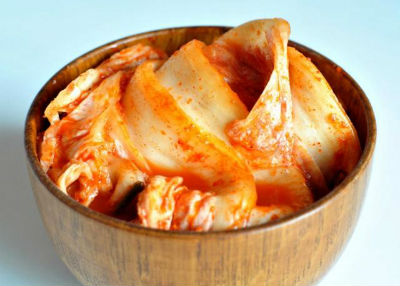
We take the following products:
- A large head of Chinese cabbage
- Six to eight cloves of garlic
- Tablespoon fish sauce (can be replaced with shrimp paste)
- Small head of onion
- A bunch of fresh green onions
- Five cm piece of ginger
- Three tablespoons red pepper flakes
- A teaspoon of odinomodo or sugar
- Carrots optional
- One and a half liters of water
- Three tablespoons (full) sea salt
Making kimchi in Korean:
First of all, we will prepare the brine correctly. It uses raw, unboiled water, so it must be very clean, filtered, ideally spring water. Stir the salt in it thoroughly until it is completely dissolved.
Separate the cabbage leaves from the head, rinse and shake off excess water, cut them into strips or squares as desired. If you use other vegetables, carrots or daikon, then it is better to grate them on a Korean grater, it will be more beautiful. Cut the onion into small strips.
We mix all the vegetables in the brine so that they are completely immersed, you can use pressure. IN summer version To prepare it, it is enough to keep them in the brine for 3-5 hours, because the temperature is higher. For winter storage It’s better to leave it to salt overnight, it will be more reliable. Afterwards, you need to drain the brine and rinse the vegetables under running water.
Next we make a paste, put garlic, pepper, ginger, fish sauce, sugar into the blender. Grind everything and mix the paste with vegetables. Do this with gloves, otherwise the pepper will burn your hands. Let's prepare a sterile jar in advance and compact the kimchi into it, close the lid and keep it at home for three to seven days.
Kim-chi - traditional classic recipe
To this recipe you can add various seasonings or additions in the form of vegetables, cauliflower inflorescences, carrots, daikon, and onions. But this is the basis, this is how our Sakhalin Koreans cook.
We will need:
- Ten kilos of Chinese cabbage
- Eight liters of clean water
- Eight hundred grams of sea coarse salt, I take pure oceanic
- Three hundred grams of garlic
- Tablespoon granulated sugar
- Cup of red pepper flakes
How to make kimchi according to the classic recipe:
First of all, we disassemble the heads of cabbage into leaves; the top ones just need to be removed, they are usually dirty and withered. We wash them and lay them out to dry. In the meantime, prepare the brine, dissolve it well in a large container. We take one so that all the cabbage fits completely; I take an ordinary plastic deep basin.
We immerse the dried leaves entirely in brine, press the lid and pressure on top, and leave to salt overnight. In the morning, remove the brine and pour a little into a half-liter jar to prepare the paste. We wash the leaves and remove excess water.
The next step is to prepare a mixture of ground garlic, pepper, adding brine and sugar to form a paste. For this recipe, the pepper is not ground, it comes in flakes, the garlic is passed through a crusher.
We rub each leaf with this infernal mixture, only with gloves on, otherwise it will burn your hands, your eyes, and your entire skin. We put the leaves in a container that you don’t mind, the smell won’t disappear from it for a long time. We put pressure on top and leave it to ferment for several days in a warm place. Then the kimchi can be put into jars and hidden in the cold.
Chinese cabbage kimchi recipe
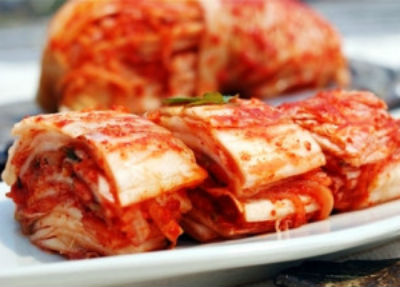
This recipe can be made at any time of the year when you want something spicy. By the way, it is not necessary to adhere exact proportions for garlic or pepper, if you cannot eat too spicy food, the main thing is to salt the cabbage well and let it marinate, then you will get that very “elixir of youth”, as the Koreans call kim-chi.
We take the following ingredients:
- Forks of Chinese cabbage per kilo
- Medium head of garlic
- Chili pepper pod
- A piece of ginger root
- Half a glass of soy sauce
- Half a cup of regular table salt
- Table spoon of sugar
- Vinegar 9% two tablespoons
- Two tablespoons of ground paprika
- Two medium onions
How to make Chinese cabbage kimchi:
We clean the forks from the upper leaves, rinse them, and cut out the stalk. Cut into four parts, then cut crosswise into cubes. Place the cabbage in a deep cup and sprinkle with salt. We press on top cover something heavy and left for a day. After draining the juice, rinse the cabbage and let the water drain.
Three ginger on a regular grater, pass the garlic through a crusher, cut the chili seeds cleaned small pieces. Add these products to the cabbage and mix.
Mix soy sauce with paprika and sugar, add to the cabbage, mix again and leave in a cold place to steep for three days. Then the salad can be put into jars.
Korean kimchi with daikon
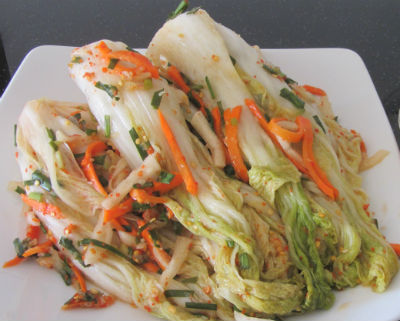
We take the following products:
- Two forks of Chinese cabbage
- One daikon root or two small radishes
- One large carrot
- head of garlic
- A piece of ginger root
- Onion
- Bunch of green onions
- Two tablespoons shrimp paste
- Chili and salt to your taste
- Two tablespoons of rice flour
- Three tablespoons of sugar or a teaspoon of odinomodo
How we will cook:
Peel the heads of cabbage from the top leaves, rinse under water, cut in half, then again lengthwise into quarters to the stalk so that they do not fall apart. We rinse it again, do not remove the water, but sprinkle the wet cabbage with salt, trying to sprinkle it evenly between the leaves. Place the salted cabbage in a container and cover it to press it down. let it salt for six hours.
Afterwards we need to prepare jelly from rice flour. Fill it with two glasses of water, add sugar and cook until thick.
While the cabbage is salting, we still have time to prepare the spicy pasta. Place garlic, ginger, pepper, onion in a blender bowl and grind everything. Grate the radish and carrots into long strips using a Korean grater. Now we mix all these vegetables with jelly, spicy paste, add shrimp sauce, stir everything.
We wash the salted cabbage in water, remove all the salt well, let the water drain and coat it all with the resulting dressing, apply it directly between the leaves. Place the kimchi in a bowl, close it and set aside to marinate for a couple of days at normal temperature.
Chinese cabbage has a more delicate consistency than its white cabbage sister, so it is often used as the main ingredient in salads. However, experienced housewives claim that pickled Chinese cabbage also has an exquisite taste and can decorate any table or diversify a salad. This appetizer can be prepared as a spicy dish, as a sweet and sour spicy preparation, can be served immediately, or can be marinated for the winter.
Chinese cabbage has a more delicate texture than its white cabbage sister.
Pickled “Peking” is considered a dish preferred on every table: festive, everyday, elegant and simple. Chinese cabbage instant cooking It is a quick snack and can be prepared just one day before consumption.
For quick pickled Beijing, you should stock up on the ingredients in advance:
- kilogram of "Beijing";
- a couple of bell peppers;
- one chili;
- a couple of large spoons of salt;
- 100 grams of sugar;
- half a glass of apple cider vinegar.
Spicy pickling is easy to prepare:
- The main ingredient is washed well, dried a little, cut into small pieces.
- The pepper is washed, the stalk and seeds are removed, and chopped into strips.
- The ingredients for the marinade are diluted in a liter of liquid and heated until boiling.
- The vegetables are mixed, chopped chili is added, and the boiling marinade is poured over.
- The snack is infused for a day in a cool place, after which it is laid out in ready-made sterile containers and stored in the refrigerator.
This spicy snack can be stored for no more than a couple of weeks, during which time it should be eaten.
Pickled Chinese cabbage (video)
Pickled kohlrabi for the winter
You can also quickly prepare a spicy pickled appetizer for winter using kohlrabi. For this dish they take young varieties, they make ready dish soft and a little crunchy at the same time.
In order to stock up on this spicy cold pickling, you should initially prepare a food set:
- kohlrabi;
- a couple of large spoons of salt;
- 80 grams of sugar;
- half a glass of apple cider vinegar;
- greens and berries optional.
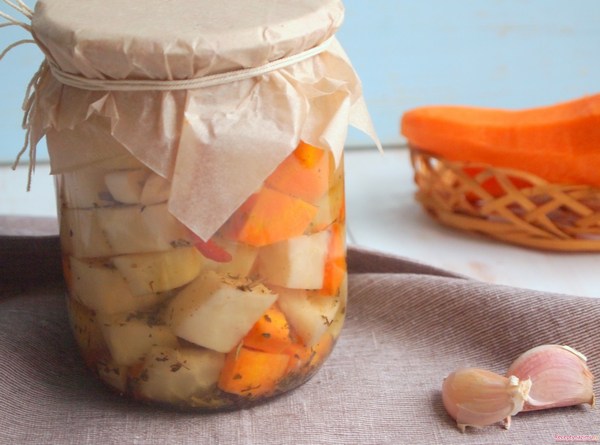
You can add carrots to the preparation
Canning this type of cabbage begins with preparing the containers: they are thoroughly washed and sterilized over steam.
- The cabbage is washed and cut into small pieces.
- Add a few drops of vinegar to a liter of liquid, bring to a boil and place kohlrabi pieces in boiling acidified water for 5 minutes.
- Place the boiled vegetable in a colander and leave for a few minutes to allow excess liquid to drain.
- Transfer the kohlrabi to prepared containers and add herbs and berries.
- Dissolve the ingredients for the marinade in a liter of liquid, add vinegar after boiling, and bring the mixture to a boil.
- Pour boiling marinade over cabbage and roll up.
The snack is kept cold: you can put it in the cellar, you can put it in the refrigerator.
Do you need to wash Chinese cabbage?
The recipes for preparing Chinese cabbage and the scope of application of this vegetable are varied. It is added to salads, pickled, canned, made into cabbage rolls, and added to first courses and vegetable side dishes.
Most housewives are wondering how to properly process Chinese cabbage and whether it needs to be washed before using it as an ingredient.
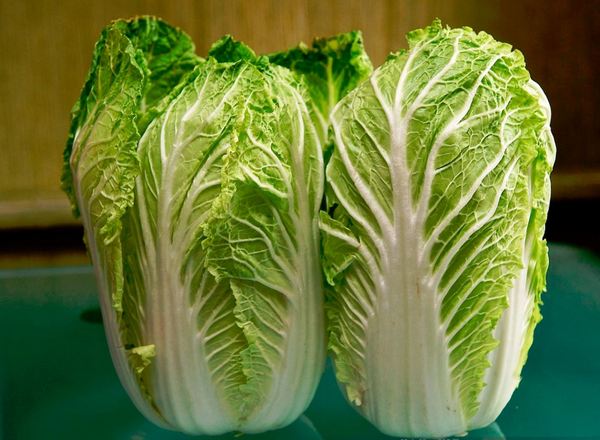
The recipes for preparing Chinese cabbage and the scope of application of this vegetable are varied.
- Immediately before using Chinese cabbage as the main ingredient, it should be thoroughly rinsed with cold running water.
- If you plan to postpone cooking the cabbage for some time, it is better to store it in the refrigerator. Before placing it in the cold, the vegetable should not be washed.
Before pickling or canning, Chinese cabbage should be thoroughly washed with running water and slightly dried before processing.
Spicy pickled cabbage
To prepare a spicy marinated appetizer, chefs recommend using spicy Bell pepper . For those who don't love much spicy dishes, it is recommended to replace the bean ingredient with a ground black analogue.
Spicy spicy cabbage is prepared from the following ingredients:
- kilogram of "Beijing";
- 300 grams of onion;
- 300 grams of bell pepper;
- hot pepper pod;
- 100 grams of sugar;
- 50 grams of salt;
- a small spoon of vinegar.
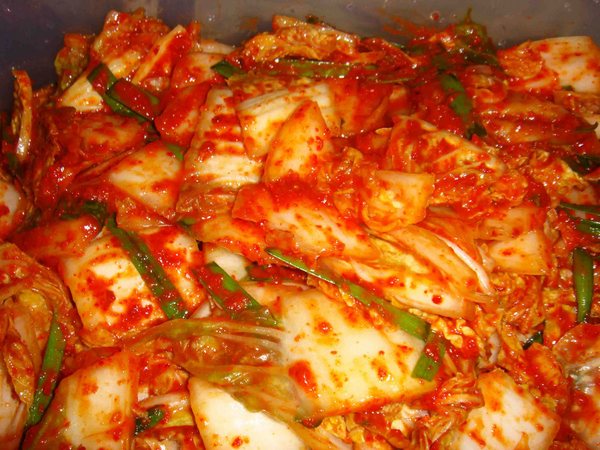
To prepare a spicy pickled snack, culinary experts recommend using hot capsicums.
Sequence of preparation of a spicy vegetable dish:
- The cabbage is washed, slightly dried, and cut into strips.
- The onion is peeled and cut into thin rings, the pepper is chopped into strips, having previously freed it from seeds and stalks.
- Chop the hot pepper into small cubes.
- The vegetables are thoroughly mixed and compacted into previously prepared glass containers.
- The ingredients for the marinade are dissolved in a liter of liquid, after boiling, vinegar is added, the contents of the jars are poured with boiling marinade, and rolled up.
After the preservation has cooled, it is sent to a cool place for long-term storage.
Salad with Chinese cabbage for the winter
A vegetable salad with Chinese cabbage is considered an original winter dish. At home, this preparation is well stored at any temperature, it is quite tasty and can serve as an indispensable side dish.
You can make a spicy “Beijing” salad from the following ingredients:
- kilogram of Chinese cabbage;
- several sweet peppers;
- a couple of carrots;
- half a kilogram of onions;
- one chili;
- a couple of large spoons of salt;
- 100 grams of sugar;
- half a glass of apple cider vinegar.
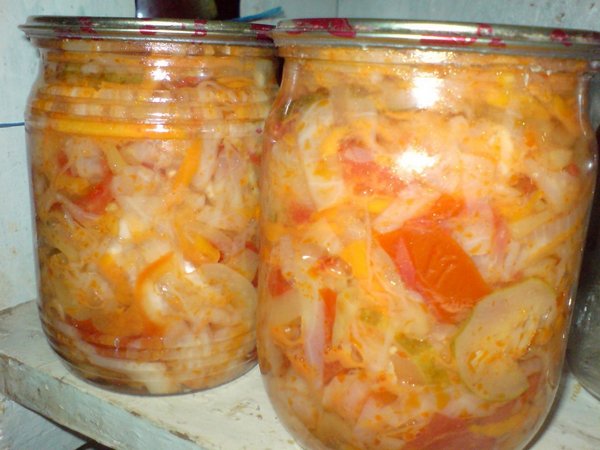
A vegetable salad with Chinese cabbage is considered an original winter dish.
Sequence of preparation of winter vitamin salad:
- The cabbage is washed, cut into large cubes, the peeled pepper is chopped into strips, the hot pepper is crushed using a meat grinder.
- The onion is peeled and chopped into thin half rings, the peeled carrots are chopped into thin strips.
- Mix the vegetables thoroughly and place the mixture in prepared sterile containers.
- Dissolve salt and sugar in a liter of water, bring the mixture to a boil, add vinegar.
- Pour the boiling marinade into the vegetable mixture in a jar and roll it up.
This salad will delight you not only with its spicy taste, but also with its aesthetic appearance. Culinary experts recommend taking red sweet and bitter peppers for it.
Chinese cabbage with beets
Preparation Chinese cabbage with beets allows you to get a bright dish that will give the covered table an aesthetic completeness. In addition, this appetizer turns out very tasty and piquant.
In order to prepare a colorful spicy pickle from Chinese cabbage, prepare the ingredients:
- 2 kilograms of “Beijing”;
- a couple of fresh carrots;
- medium beetroot;
- a clove of garlic;
- a glass of vegetable oil;
- 200 grams of sugar;
- a couple of large spoons of salt;
- 150 grams of vinegar;
- pepper mixture.
Step-by-step cooking recipe:
- Chinese cabbage is washed and cut into large pieces.
- Peel carrots and beets, chop into thin strips, and mix with cabbage cubes in a clean enamel container.
- The ingredients for the marinade are dissolved in a liter of liquid and sent to the fire. After boiling, add vinegar and a mixture of peppers.
- Pour boiling marinade over vegetables and place pressure on top. Insist for a day in natural conditions.
- Transfer the prepared pickling mixture into prepared sterile containers and store it in a cold place.
Korean-style pickled Chinese cabbage (video)
Recipes for pickling and canning Chinese cabbage differ in their variety and ingredients. All of them allow you to prepare a tasty and aromatic dish; Peking is equally tasty, salty, hot, spicy, and sweet and sour.
And a little about secrets...
Have you ever experienced unbearable joint pain? And you know firsthand what it is.
Kimchi (aka kimchi, kim chi, chimchi...) is a spicy Korean snack based on Chinese cabbage. There are more than 100 varieties and ways of preparing this salad: the imagination of Korean chefs knows no bounds!
We invite you to try the most optimal kimchi recipe (without using exotic ingredients such as fish sauce). Peking cabbage prepared in this way turns out juicy with a rich, moderately spicy taste.
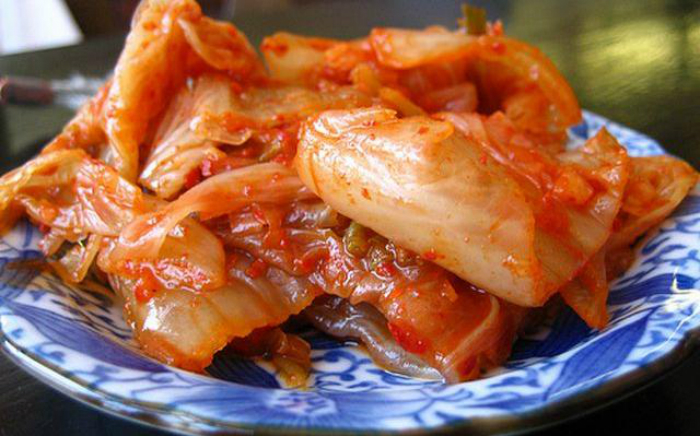
Chinese cabbage kimchi
INGREDIENTS
- 1 fork (weighing up to 1.5 kg) Chinese cabbage
- 1 tbsp. l. ground chili pepper (less possible)
- 4–5 cloves of garlic
- slice (2 cm) fresh ginger root
- 1 tsp. ground coriander
- 1 tbsp. l. vegetable oil
- 1 tsp. Sahara
- 4–5 tbsp. l. salt
- 1.5–2 liters of water
- sesame seeds for sprinkling
COOKING
- Cut the cabbage lengthwise into 4 parts and place in a suitable container. Boil water, dissolve salt and pour the already cooled brine over the cabbage. Cover with a plate so that the cabbage is completely in the brine, and leave for 12 hours (overnight is more convenient) at room temperature.
- Prepare a dressing for cabbage by mixing pressed garlic, grated ginger root, coriander, sugar and chili pepper to form a thick paste. You can add another pinch of salt.
Vary the amount of pepper, because this is a purely individual matter: some people like it spicier, while for others even a pinch is too hot.
- Salted cabbage rinse, then drain, cut into squares and mix with dressing. Place in a container, cover and leave to ferment at room temperature for 1-2 days. After this, the cabbage can be stored in the refrigerator.
- Serve the snack, watering vegetable oil and sprinkle with sesame seeds.
Chinese cabbage contains a special beneficial substance - lysine, which has the ability to cleanse the blood, improve immunity and even defeat cancer cells. Koreans believe that kimchi promotes the absorption of subcutaneous fat, normalizes digestion and helps absorb food.
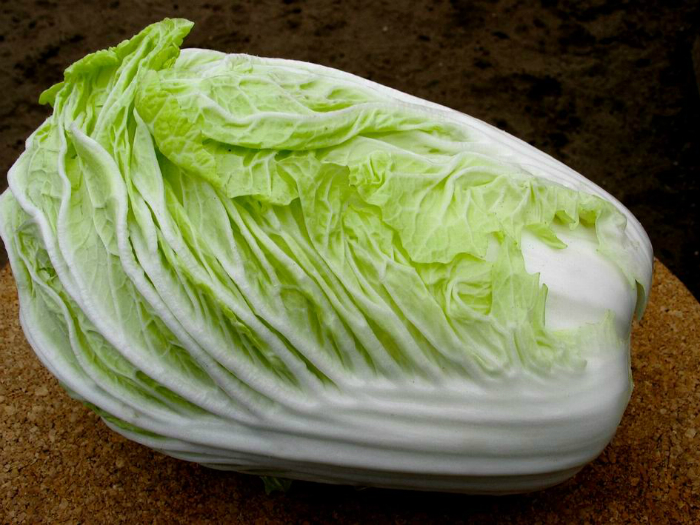
This oriental snack is also an excellent anti-cold remedy, because, as you know, fermented vegetables contain more vitamin C than regular ones. Ginger and garlic also do their healing work!
Another dish that I learned from the Sakhalin Koreans. Koreans prepare this kind of cabbage the same way Russians ferment cabbage - in barrels, for future use, in late autumn. Now, of course, during the period of development of all kinds of technologies, the need for barrels has disappeared, and wonderful refrigerators have appeared, specially designed for storing kim chi. And they started selling cabbage itself all year round, it became possible not to cook, as before, tens and even hundreds of kilograms (when I lived on Sakhalin, I prepared up to 150 kg of cabbage for the winter).
In Korean cuisine, such cabbage is eaten either on its own - simply chopped - or added to various dishes - when cooking pork, dumplings, manti, pyan se, cabbage rolls, minced meat for various dishes, and even in soups.
To diversify the taste when preparing kim chi, daikon radish can be added to it, layered between cabbage, red fish, and white cabbage.
You can also cook white cabbage separately using this recipe. ALSO very tasty, only compared to kim chi from Chinese cabbage White cabbage it turns out crispier.
As a rule, kim chi is eaten with more bland foods: boiled unleavened rice, broth, boiled meat, noodles.
The recipe is designed for a small amount of kim chi, with the intention of “tasting it.” If you like it, then all the norms can be increased by a factor of the amount of cabbage harvested next time. Yes, and to be honest, what is important is not so much the ratio of products (each housewife makes it to her own taste, depending on the love of spicy food in the family), but the technology of preparation and storage itself.
Required Products:
- Chinese cabbage (about 2.5-3 kg)
- garlic (3 large heads)
- salt (0.25-0.3 kg)
- red hot pepper, coarsely ground (flakes, sold by weight, volume equal to the volume of garlic).
Preparation:
The most important thing is to choose the right Chinese cabbage. It should not be completely white, but not very green either; choose thicker heads of cabbage - such cabbage will be juicier and tastier.
We remove damaged leaves from the heads of cabbage and trim the edges of the stalks. There is no need to wash the cabbage.
Cut lengthwise into four parts (in half, then each part in half again). If the heads of cabbage are not large, then it is enough to cut them only into halves.
Opening each part like a fan, rub the cabbage with salt. To ensure that the salt evenly covers each leaf, the cabbage can be dipped in water and allowed to drain.
Place the salted cabbage tightly, but without compacting, into the selected container (basin, large container, pan, do not use aluminum cookware- it oxidizes). In this form, we leave the cabbage to salt in a warm place for about a day.
After a day (you can do it in a day and a half to two days, nothing bad will happen if the cabbage is a little too salty), rinse the cabbage from the remaining salt and pour cold water for about a couple of hours, so that the excess salt is gone (if you salted the cabbage for more than a day, then you need to soak it a little longer, you can even leave it like that overnight).
After soaking, drain the water and leave the cabbage in a colander or on a wire rack so that all the water drains out. 20 minutes is enough.
While the cabbage is soaking and draining, you can start preparing the garlic-pepper paste.
This is where rubber gloves come in handy (can be household or medical, it doesn’t matter, the main thing is to protect your hands from pepper and garlic, otherwise it will take at least a week to restore their beauty, and you won’t immediately get rid of the smell of garlic).
Peel the garlic and pass it through a press.
To the garlic add an equal volume of red, coarsely ground flakes, hot pepper.
Mix well. By the way, Koreans also prepare this pasta for future use and store it in the refrigerator. Very convenient if you often prepare Korean salads.
When the cabbage is glassed, we take on the final touch. Each part of the cabbage, as when pickling, is fanned out and evenly rubbed with the prepared garlic-pepper paste, each leaf, again hiding your hands in rubber gloves - this way they will be more intact, more beautiful and the smell of garlic will not discourage your loved one from kissing her on occasion: ).
Place the cabbage, grated with garlic and pepper, tightly (but without compacting) into the container in which it will be stored. I’ll make a little reservation here - you should choose dishes so that you don’t use them for anything later, because they are saturated with the smell of garlic and pepper and this smell cannot be removed. And the lid of such dishes should fit tightly enough so as not to permeate all the other foods in the refrigerator with the smell of garlic. For such purposes, I usually leave plastic containers like these left over from store-bought kebab or mayonnaise.
So, rub the cabbage with garlic-pepper paste, place it in a container reserved for this purpose, tightly close the lid and leave it warm for about a day. It is advisable from time to time to release the air formed during pickling from the cabbage.
A day later, once again releasing the air from the cabbage, close it tightly and put it in a cool place. After about a week and a half, the cabbage is ready!
BON APPETIT!!!





